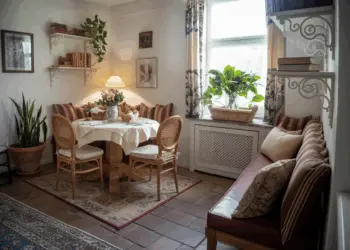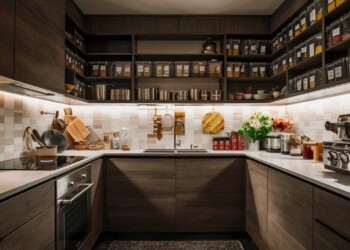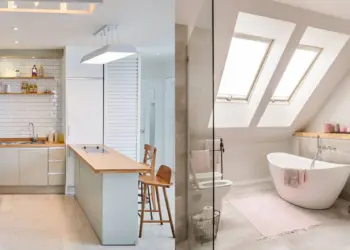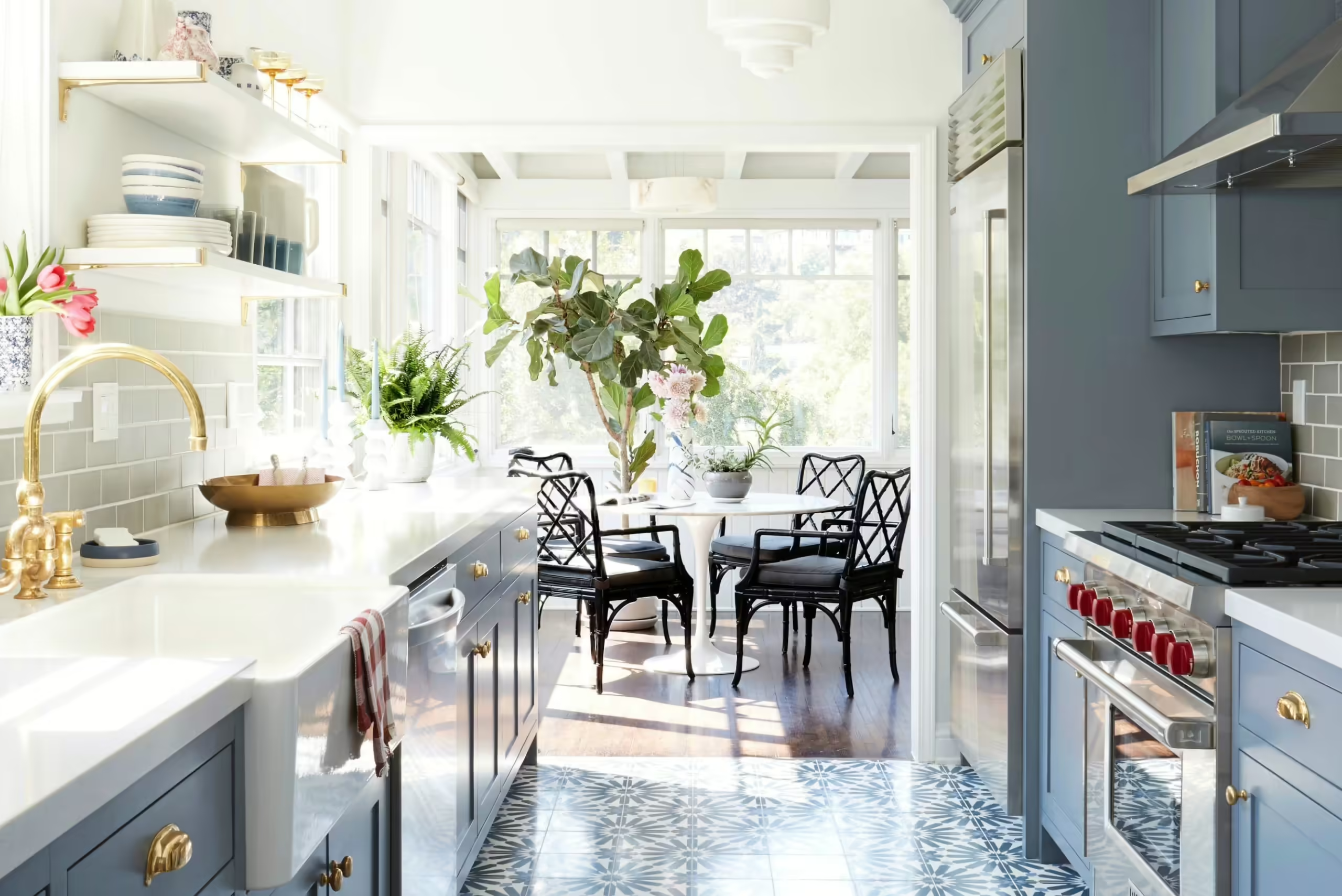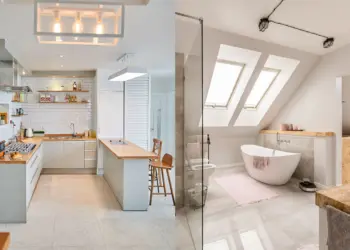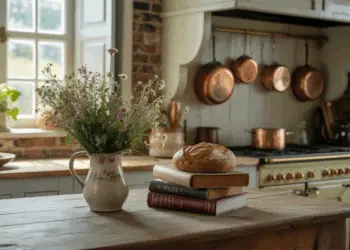Designing your kitchen layout is a creative and practical endeavor. It’s about creating a space that not only serves your cooking needs but also adds value to your home and enhances your daily life.
The kitchen is frequently referred to as the home’s heart in the field of interior design. Families gather here to cook and eat meals together, to express their creativity in the kitchen, and to create lasting memories. Your kitchen’s design is extremely important to both its functioning and appearance. We’ll dig into the art of kitchen layout in this complete guide, looking at different layouts, ideas, and suggestions to help you build the kitchen of your dreams.
Table of Contents
The Importance of Kitchen Layout
Interior designers typically refer to the kitchen as the “heart” of the house. Families congregate here to prepare and enjoy meals collectively, to cook creatively, and to make enduring memories. The layout of your kitchen has a big impact on how it looks and functions. In this comprehensive book, we’ll go deep into the art of kitchen layout, looking at various plans, concepts, and recommendations to support you in creating the kitchen of your dreams.

Recognizing Different Kitchen Layouts
2.1. Single Wall kitchen layout
For smaller areas or open floor designs, the single wall kitchen layout is perfect. It streamlines the appearance by aligning all of the cabinets, counters, and appliances along the same wall.

2.2. Galley Kitchen Layout
A center aisle and two parallel countertops define a galley kitchen layout. They increase effectiveness but need careful design to prevent a claustrophobic sensation.

2.3. L-Shaped Kitchen Layout
The L-shaped design provides versatility and lots of counter space. It provides for simple traffic flow and is ideal for corner situations.

2.4. U-Shaped Kitchen Layout
With cabinets and counters on three sides, a U-shaped kitchen layout gives you plenty of workspace and storage. They work well in bigger kitchens.

2.5. Island Kitchen Layout
The L-shaped design provides versatility and lots of counter space. Island designs have a central island that provides additional storage and a space for informal dining. They are well-liked for their elegance and adaptability.

Factors to Consider in Kitchen Layout
3.1. Space and Size
Which kitchen layout is best for you depends depend on the size of your kitchen. Think about the space you have and how it can meet your needs.
3.2. Workflow Efficiency
The foundation of an effective kitchen layout is a carefully thought-out workflow. The space around the stove, sink, and refrigerator-the work triangle-should be clear.
3.3. Storage Solutions
Ample storage is essential. Think about pantry space, cabinetry, and innovative storage solutions like pull-out drawers and shelves.
3.4. Traffic Flow
Your kitchen will be user-friendly thanks to a sensible traffic flow. Avoid places of congestion and bottlenecks.
3.5. Design Aesthetics
Maintain a balance between the two. Pick materials, colors, and finishes that support your design philosophy.

Ergonomics in Kitchen Design
4.1. The Work Triangle
The work triangle should be efficient yet comfortable. Strive for a balance between the stove, sink, and refrigerator.
4.2. Counter Heights
Different counter heights serve various purposes. Plan your counter heights according to your needs, from food prep to dining.
4.3. Appliance Placement
Consider the placement of appliances like ovens and dishwashers. They should be within reach and strategically located.

Choosing the Right Materials and Finishes
5.1. Countertops
Countertops are both functional and decorative. Granite, quartz, and marble are popular choices for durability and aesthetics.
5.2. Cabinetry
Cabinets define the style of your kitchen. Explore options like shaker, flat-panel, and open shelving for a personalized look.
5.3. Flooring
Choose flooring materials that are easy to clean and withstand heavy foot traffic. Options include hardwood, tile, and laminate.
5.4. Backsplash
A stylish backsplash can elevate your kitchen’s design. Explore subway tiles, mosaic patterns, and natural stone options.

Lighting Your Kitchen
6.1. Task Lighting
Task lighting ensures proper illumination for cooking and food prep. Under-cabinet lights and pendant lights are popular choices.
6.2. Ambient Lighting
Ambient lighting sets the mood in your kitchen. Consider chandeliers, recessed lighting, or track lighting for a welcoming atmosphere.
6.3. Accent Lighting
Accent lighting highlights specific areas or features. Showcase your kitchen’s beauty with well-placed accent lights.

The Importance of kitchen layout dimensions
some standard kitchen layout dimensions to consider when planning your kitchen design:
- Counter Height and Depth:
- Standard Counter Height: 36 inches
- Counter Depth: 24 inches
- Cabinet Dimensions:
- Base Cabinet Depth: 24 inches
- Wall Cabinet Height: 30 inches (with 12 inches of space between countertop and wall cabinets)
- Wall Cabinet Depth: 12 inches
- Kitchen Island Dimensions:
- Standard Island Height: 36 inches
- Island Depth: 36 inches
- Appliance Dimensions:
- Refrigerator Depth: 30 to 34 inches
- Oven Dimensions: 30 inches wide
- Walkway Width:
- Minimum Walkway Width: 36 inches
- Ideal Walkway Width: 42 inches
- Sink Dimensions:
- Sink Width: 22 inches
- Sink Depth: 30 inches
- Work Triangle Dimensions:
- The sum of the three sides of the work triangle (connecting the refrigerator, stove, and sink) should be between 13 and 26 feet for maximum efficiency.
- Clearances:
- Clearance Between Appliances and Cabinets: 3 inches
- Clearance Between Appliances and Walls: 3 inches
- Clearance Between Island and Cabinets: 42 inches
- Ventilation Dimensions:
- Standard Range Hood Width: 30 inches
- Range Hood Height Above Cooktop: 24 to 30 inches
- Seating Dimensions:
- Recommended Space per Person: 24 inches
- Recommended Overhang for Seating: 12 inches
Remember, these dimensions serve as general guidelines, and actual dimensions may vary based on individual preferences, kitchen size, and specific needs. It’s crucial to tailor these dimensions to your unique space and lifestyle requirements to create a functional and aesthetically pleasing kitchen layout.

Incorporating Smart Technology
8.1. Smart Appliances
Smart appliances offer convenience and efficiency. From refrigerators with touch screens to voice-controlled ovens, the options are vast.
8.2. Home Automation
Integrate your kitchen into your smart home system. Control lighting, temperature, and even your coffee maker with a simple voice command.

Budgeting and Hiring Professionals
9.1. Setting a Budget
Determine your budget early in the planning process. It will guide your choices and help you avoid overspending.
9.2. DIY vs. Hiring a Designer
Decide whether you’ll tackle the project yourself or hire a professional designer. Consider your skills, time, and the complexity of the project.

The Kitchen Layout Trends of 2023
Stay ahead of the curve by exploring the latest kitchen design trends. From bold colors to sustainable materials, discover what’s hot in 2023.

Crafting Your Perfect Kitchen
Designing your kitchen layout is a rewarding journey. By considering factors like space, workflow, materials, and technology, you can create a culinary haven that suits your lifestyle and tastes. Whether you’re a passionate home cook or simply enjoy spending time in the kitchen, a well-designed layout can make your culinary experience more enjoyable and efficient.
As you embark on this journey to craft your perfect kitchen, keep in mind the following key takeaways:
- Personalization: Your kitchen should reflect your personality and cooking style. Don’t be afraid to add unique touches that make it truly yours.
- Functionality: Prioritize functionality above all else. The layout should make your daily tasks easier and more efficient.
- Balance: Achieve a balance between aesthetics and practicality. Your kitchen should be visually appealing while still meeting your functional needs.
- Quality Materials: Invest in high-quality materials that will stand the test of time. Well-constructed cabinets, durable countertops, and reliable appliances are essential.
- Stay Informed: Stay updated on the latest kitchen layout design trends and technologies. Incorporating modern elements can enhance your kitchen’s overall appeal.
- Professional Advice: If you’re uncertain about the design process, consider consulting with a professional kitchen designer or contractor. Their expertise can be invaluable.

Now, you may have some questions about kitchen layouts and design. Let’s address a few common queries:
FAQs
What is the most popular kitchen layout in modern homes?
The open-concept kitchen, which often features an island, has become increasingly popular in modern homes. It creates a spacious and inviting environment, perfect for both cooking and socializing.
How can I maximize storage in a small kitchen layout?
To maximize storage in a small kitchen layout, consider using vertical space with tall cabinets, utilize pull-out shelves and organizers, and opt for multifunctional furniture like kitchen islands with built-in storage.
Are there eco-friendly options for kitchen materials?
Yes, there are many eco-friendly options for kitchen materials. Sustainable choices include bamboo or reclaimed wood for cabinetry, recycled glass countertops, and energy-efficient appliances.
What lighting fixtures work best in a kitchen layout?
Task lighting, such as under-cabinet lights and pendant lights, is ideal for kitchen work areas. Ambient lighting can create a warm and inviting atmosphere, while accent lighting can highlight specific features.
How can I incorporate smart technology into my kitchen layout?
You can incorporate smart technology by investing in appliances with Wi-Fi connectivity, installing smart lighting systems, and integrating voice-controlled assistants like Amazon Alexa or Google Assistant.
In conclusion, designing your kitchen layout is a creative and practical endeavor. It’s about creating a space that not only serves your cooking needs but also adds value to your home and enhances your daily life. With careful planning, attention to detail, and a touch of personal style, you can transform your kitchen into a culinary masterpiece.

